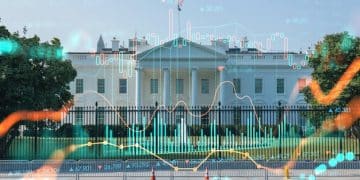US Stock Market’s 3.5% Q1 2025 Growth Drivers Unveiled

The projected 3.5% growth in the US stock market for Q1 2025 is primarily driven by an anticipated economic soft landing, continued corporate earnings resilience, a dovish shift in the Federal Reserve’s monetary policy, and robust technological advancements.
Understanding what’s driving the projected 3.5% growth in the US stock market for Q1 2025 is crucial for investors navigating the complexities of modern finance. This anticipated increase reflects a confluence of economic indicators and market forces that suggest a cautiously optimistic outlook for the coming quarter.
The Soft Landing Narrative: A Foundation for Growth
The concept of a “soft landing” has become a recurrent theme in economic discussions, particularly as central banks around the world, including the US Federal Reserve, grapple with inflation. A soft landing implies an economic slowdown that successfully curbs inflation without triggering a recession. For the US stock market, this scenario is a prime driver of the projected 3.5% growth in Q1 2025.
Investors thrive on predictability and stability. A soft landing provides exactly that, reducing the fear of a sharp economic contraction that could severely impact corporate earnings and consumer spending. The market’s anticipation of such an outcome encourages investment and reduces volatility, fostering an environment where growth can occur.
Inflation Management and Consumer Confidence
One of the key pillars supporting the soft landing narrative is the effective management of inflation. Years of elevated inflation have eroded purchasing power and introduced uncertainty. As inflation moderates, economists expect a gradual restoration of consumer confidence, which is vital for economic activity.
- Stabilizing Prices: Declining inflation rates provide consumers and businesses with greater certainty about future costs, enabling better planning.
- Restored Purchasing Power: As price increases slow, real wages may begin to catch up, leading to increased consumer spending.
- Reduced Economic Uncertainty: A stable inflationary environment minimizes the need for drastic monetary policy shifts, promoting market stability.
Moreover, robust employment figures, even in the face of slowing economic growth, contribute significantly to consumer confidence. A tight labor market, where job opportunities remain plentiful, reassures households about their financial security, making them more likely to spend and invest.
In summary, the expectation of a soft landing, characterized by controlled inflation and a resilient job market, forms a crucial psychological and fundamental bedrock for the anticipated stock market gains in Q1 2025. This allows for a more optimistic outlook on future corporate profitability and overall economic health.
Corporate Earnings Resilience: Exceeding Expectations
At the heart of any stock market growth lies corporate profitability. The projected 3.5% growth for the US stock market in Q1 2025 heavily relies on the continued resilience, and in some cases, surprising strength, of corporate earnings. Despite various economic headwinds that have emerged in recent years, many companies have demonstrated remarkable adaptability and efficiency.
Examining recent earnings reports reveals a pattern of companies either meeting or exceeding analyst expectations. This trend is not uniform across all sectors, but it is sufficiently widespread to paint an optimistic picture for the broader market. Sectors that have shown particular strength include technology, healthcare, and consumer discretionary goods, driven by innovation, demographic shifts, and evolving consumer preferences.
Strategic Cost Management and Revenue Diversification
Companies have not achieved these positive results by chance. Many have implemented aggressive cost-cutting measures, optimized supply chains, and diversified their revenue streams. These strategic adjustments have allowed them to maintain healthy profit margins even in a challenging economic landscape.
- Operational Efficiency: Investments in automation and process optimization have lowered operating costs.
- Supply Chain Robustness: Companies have built more resilient supply chains, reducing disruptions and associated expenses.
- Market Diversification: Expanding into new geographic markets or product categories has mitigated risks associated with reliance on single markets.
Furthermore, the ability of companies to pass on some increased costs to consumers, albeit carefully, has also contributed to maintaining revenue levels. This “pricing power” is often a hallmark of strong brands and essential service providers, allowing them to navigate inflationary pressures more effectively than others.
The consistent delivery of solid earnings, coupled with forward-looking guidance that projects continued growth, instills confidence in investors. This confidence is a significant engine behind the anticipated market expansion, as it validates current valuations and attracts new capital. Investors are continually seeking companies that can demonstrate sustainable profitability and strategic agility in an ever-changing global economy.
The Federal Reserve’s Dovish Pivot and Interest Rate Expectations
Monetary policy, particularly the actions of the Federal Reserve, exerts an undeniable influence on the stock market. The anticipation of a “dovish pivot”—a shift towards less restrictive monetary policy, primarily through interest rate cuts—is a critical factor contributing to the projected 3.5% growth in Q1 2025.
For an extended period, the Fed has maintained a hawkish stance, raising interest rates to combat persistent inflation. While necessary, higher rates typically dampen economic activity by increasing borrowing costs for businesses and consumers, which can negatively impact stock valuations. A pivot to rate cuts would signal the Fed’s confidence in bringing inflation under control and its willingness to support economic growth.
Impact of Lower Interest Rates
Lower interest rates have several positive implications for the stock market. They reduce the cost of capital for businesses, making it cheaper to borrow for expansion, innovation, and other investments. This can directly boost corporate profitability and, consequently, stock prices.
- Reduced Borrowing Costs: Companies benefit from lower interest payments on their debts, freeing up capital for growth.
- Increased Investment: Cheaper credit encourages businesses to invest in new projects, hiring, and research and development.
- Attractive Equity Valuations: As interest rates fall, the present value of future corporate earnings increases, making stocks more attractive relative to fixed-income investments.
Moreover, lower rates can stimulate consumer spending, as borrowing for mortgages, auto loans, and other purchases becomes more affordable. This boost in consumer demand directly translates into higher revenues for businesses, further supporting stock market gains. The market tends to react favorably to the anticipation of such changes, often pricing in the expected cuts before they even occur.

The careful communication from the Federal Reserve regarding its future policy intentions plays a crucial role. Any signals hinting at rate cuts are usually met with positive market sentiment. However, the timing and magnitude of these cuts are keenly watched, as too rapid a series of cuts could signal underlying economic weakness, while too slow a pace might restrain growth. The current projection suggests a balanced approach, fueling optimism for Q1 2025.
Technological Innovation and AI Integration: A New Growth Engine
Beyond traditional economic indicators, the relentless pace of technological innovation, particularly in artificial intelligence (AI), is carving out new avenues for growth across the US economy. This wave of innovation is expected to be a significant contributor to the projected 3.5% stock market growth in Q1 2025, offering both direct investment opportunities and profound productivity enhancements.
AI’s transformative potential spans virtually every sector, from healthcare and finance to manufacturing and retail. Companies at the forefront of AI development and adoption are seeing accelerated growth in revenue and market capitalization. This isn’t just about the “tech giants”; it’s also about a multitude of smaller, innovative companies developing specialized AI solutions.
AI’s Broad Economic Impact
The impact of AI extends beyond the companies developing the technology itself. Its integration into existing industries is leading to substantial productivity gains, operational efficiencies, and the creation of entirely new products and services. This systemic transformation has a ripple effect throughout the economy.
- Enhanced Productivity: AI tools are enabling businesses to automate tasks, optimize processes, and make data-driven decisions more effectively.
- New Markets and Services: AI is giving rise to novel applications and business models, opening up new revenue streams and market segments.
- Competitive Advantage: Companies investing in AI are gaining a significant edge over competitors, leading to increased market share and profitability.
The advancements in generative AI, machine learning, and automation are not merely theoretical; they are already being scaled and deployed, promising tangible economic benefits. From personalized customer experiences to advanced drug discovery, AI is driving efficiencies and fostering innovation at an unprecedented rate. This creates a strong bullish sentiment for companies that are either leading in AI development or are successfully integrating AI into their core operations.
The excitement surrounding AI is not just speculative. It’s rooted in demonstrable improvements in business outcomes and a clear roadmap for future growth. Investors are keenly aware of the long-term potential of these technologies, making tech-heavy sectors a strong driver for overall market performance as we approach Q1 2025.
Global Economic Rebound and Supply Chain Normalization
The US stock market does not operate in isolation. Its performance is intrinsically linked to the health of the global economy. A projected global economic rebound, coupled with the ongoing normalization of supply chains, is another key factor underpinning the expected 3.5% growth for Q1 2025. As major economies outside the US regain momentum, it creates a more favorable environment for American multinational corporations and exporters.
Many countries, particularly in Europe and Asia, have faced their own unique economic challenges in recent years. Signs of recovery in these regions, driven by factors like moderating inflation, stabilizing energy markets, and government stimulus measures, contribute to a stronger global demand picture. This increased demand translates into higher sales and profits for US companies operating internationally.
Easing Supply Chain Pressures
The disruptions to global supply chains caused by geopolitical events and the pandemic have been a significant drag on corporate profitability and economic growth. However, there has been a steady improvement in logistics, manufacturing, and inventory management, leading to a normalization of supply chain operations.
- Reduced Shipping Costs: Lower freight rates alleviate cost pressures on businesses and ultimately consumers.
- Improved Inventory Levels: Companies can manage their stock more efficiently, reducing waste and carrying costs.
- Enhanced Production Stability: Fewer supply bottlenecks mean more consistent production and delivery schedules.

Moreover, the increased stability in global trade allows businesses to plan more effectively and reduce the need for costly contingency measures. This efficiency gain contributes directly to better earnings and improved investor sentiment. The interconnectedness of modern economies means that a global updraft can provide a powerful tailwind for the US market.
While some risks persist, such as ongoing geopolitical tensions, the general trend towards global economic recovery and more robust supply chains provides a supportive backdrop for US stock market performance. This creates a broader base of revenue and profit opportunities for publicly traded companies, reinforcing the positive outlook for early 2025.
Robust Job Market and Consumer Spending Outlook
A healthy labor market is frequently cited as a bedrock of strong consumer spending, which in turn fuels corporate revenues and stock market growth. The US has demonstrated remarkable resilience in its job market, consistently adding jobs and maintaining low unemployment rates, even in periods of economic uncertainty. This robust employment picture is a pivotal element in the forecast for 3.5% growth in Q1 2025.
When individuals are employed and feel secure in their jobs, they are more likely to spend on goods and services, invest, and contribute to the economic cycle. Wage growth, while carefully monitored for inflationary pressures, has also provided consumers with increased purchasing power. This combination creates a virtuous cycle where employment drives spending, which drives corporate earnings, and subsequently, stock market performance.
Labor Market Dynamics and Future Trends
The dynamics of the labor market are complex, evolving with technological shifts, demographic changes, and policy adjustments. For Q1 2025, the expectation is that these trends will largely remain favorable, supporting continued consumer confidence and spending. There’s a particular focus on sectors that are expanding and creating new job opportunities.
- Sectoral Growth: Industries like technology, healthcare, and renewable energy continue to be strong job creators.
- Moderate Wage Growth: Sustainable wage increases support consumer spending without overheating inflation.
- Low Unemployment: A tight labor market empowers workers and keeps consumer sentiment positive.
Understanding the nuances of consumer behavior is also important. Even as price sensitivity remains, a strong employment backdrop allows for a degree of discretionary spending that supports a wide range of industries, from retail to travel and leisure. Confidence in future employment prospects often translates into bigger purchases and longer-term financial commitments, all of which contribute to economic vitality.
In essence, the ongoing strength of the US job market provides a critical foundation for consistent consumer spending. This economic engine directly translates into revenue for corporations and fosters an environment conducive to stock market growth. The stability and positive outlook of the labor force are thus integral to achieving the projected gains in early 2025.
| Key Growth Factor | Brief Description |
|---|---|
| 🤝 Soft Landing Expectation | Economy slows without recession, fostering stability and investor confidence. |
| 📈 Corporate Earnings Strength | Companies continue to meet or exceed profit forecasts through adaptation. |
| 📉 Fed’s Dovish Shift | Anticipated interest rate cuts reduce borrowing costs and boost valuations. |
| 🤖 Tech Innovation & AI | AI-driven productivity gains and new market creation fuel growth. |
Frequently Asked Questions About Q1 2025 Market Growth
A “soft landing” refers to an economic slowdown that successfully reduces inflation without triggering a recession. For the stock market, this scenario creates a stable environment, reduces economic uncertainty, and prevents drastic drops in corporate earnings, fostering investor confidence and paving the way for moderate growth.
Corporate earnings are fundamental to stock market performance. Strong, consistent earnings indicate healthy company financials and operational efficiency. When companies meet or exceed profit expectations, it validates their valuations and attracts more investment, directly contributing to overall market growth, as projected for Q1 2025.
A “dovish pivot” signifies a shift in the Federal Reserve’s monetary policy towards a less restrictive stance, typically involving interest rate cuts. These cuts reduce borrowing costs for businesses and consumers, stimulate investment and spending, and can make equity valuations more attractive compared to fixed-income assets, boosting market sentiment.
AI’s growing influence on the US stock market is significant, driving productivity gains across various sectors and creating new product offerings. Companies leveraging AI effectively see improved operational efficiencies and competitive advantages. This technological wave generates investor excitement and contributes to growth, especially in tech-heavy sectors that lead AI development and integration.
The global economy plays a crucial role as US multinational corporations rely on international markets for revenue. A global economic rebound, coupled with normalized supply chains, increases demand for American goods and services abroad. This improved international trade environment directly boosts US corporate earnings and overall stock market performance, offering a significant tailwind.
Conclusion
The projected 3.5% growth in the US stock market for Q1 2025 is not an isolated forecast, but rather the culmination of several interconnected and powerful economic forces. From the anticipated soft landing of the economy and the continued resilience of corporate earnings to the Federal Reserve’s likely dovish pivot and the transformative power of technological innovation, particularly AI, the outlook is cautiously optimistic. These domestic drivers are further bolstered by a strengthening global economic landscape and the normalization of supply chains, creating a conducive environment for market expansion. While uncertainties always persist in financial markets, the current trajectory suggests a period of sustained, albeit moderate, growth. Investors will continue to monitor these key indicators, seeking opportunities within this dynamic financial landscape.





